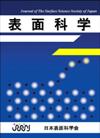All issues

Successor
Volume 31, Issue 10
Displaying 1-8 of 8 articles from this issue
- |<
- <
- 1
- >
- >|
Preface
-
Bunsho OHTANIArticle type: Preface
2010 Volume 31 Issue 10 Pages 517
Published: October 10, 2010
Released on J-STAGE: October 21, 2010
JOURNAL FREE ACCESSDownload PDF (159K)
Special Issue on Nanoparticles—Structure and Functionality
-
Bunsho OHTANIArticle type: Current Topic
2010 Volume 31 Issue 10 Pages 518-524
Published: October 10, 2010
Released on J-STAGE: October 21, 2010
JOURNAL FREE ACCESSDesign and fabrication of nano or mesoparticles with chemical and optical functions through regulation of their structure and shape are discussed, introducing jingle bell-shaped metal chalcogenide, such as cadmium sulfide, nanoparticles with silica shells, hollow core-shell mesoparticles of titania with silica shells, octahedral and decahedral titania mesoparticles, and flake ball-shaped bismuth tungstate particles of assemblies of nanoplates, all of which are prepared chemically.View full abstractDownload PDF (673K) -
Hideto IMAIArticle type: Current Topic
2010 Volume 31 Issue 10 Pages 525-530
Published: October 10, 2010
Released on J-STAGE: October 21, 2010
JOURNAL FREE ACCESSDynamical surface oxidation properties of platinum nanoparticles in an aqueous solution were observed in situ and in real-time via time-resolved synchrotron radiation techniques, energy-dispersive X-ray absorption spectroscopy and hard X-ray diffraction. The results revealed that the oxidation progress via OH, O adsorption, α-PtO2 formation and β-PtO2 phase transition, which gives possible explanations for the place-exchange oxidation process and the oxidative degradation of platinum catalysts.View full abstractDownload PDF (794K) -
Satoshi YASUDA, Mai TAKASE, Hideki NABIKA, Kei MURAKOSHIArticle type: Current Topic
2010 Volume 31 Issue 10 Pages 531-536
Published: October 10, 2010
Released on J-STAGE: October 21, 2010
JOURNAL FREE ACCESSWe present our recent studies related to an optical coupling between molecules and a localized enhanced electromagnetic field at well-defined metal nano-structure. Strong and anisotropic electromagnetic field, which is induced by localized surface plasmon at vicinity of metal surface under photo irradiation, was created by fabricating the optimized metal nano-structutre. Utilizing this system, surface-enhanced Raman scattering (SERS) studies were perfromed for molecules at the well-defined metal gap. First of all, we will demonstrate that obtained SERS spectra for two bipyridine molecules in solutions containing different concentrations originate from a few numbers of molecules at the active site of the metal dimer. Second, we introduce our current topic related to highly efficient SERS measurement for an isolated single-walled carbon nanotube (SWNT). We proved that the local electromagnetic field at the metal nano dimer allows us to probe localized optical response of a isolated SWNT at a single molecular level.View full abstractDownload PDF (934K) -
Yoshihide WATANABE, Hirohito HIRATA, Noritake ISOMURAArticle type: Current Topic
2010 Volume 31 Issue 10 Pages 537-542
Published: October 10, 2010
Released on J-STAGE: October 21, 2010
JOURNAL FREE ACCESSThe research focused on chemical properties on surface deposited mass-selected Ptn clusters from the viewpoint of size-specificities and cluster-support interaction, is expected the key technology for reduction of precious metal usage of heterogeneous catalysts such as automotive exhaust catalysts. Mass-selected Ptn clusters are deposited on a TiO2(110) surface, catalytic activity measurements with a high pressure reaction cell show CO oxidation activities of mass-selected Ptn clusters have a cluster size discontinuous dependency. We also obtained atomic-resolutional scanning tunneling microscope (STM) images of mass-selected clusters on surfaces, enabling the identification of atomic alignments in the clusters on the surface. Clusters smaller than Pt7 lay flat on the surface with a planar structure and a planar-to-3D transition occurred at n=8 for Ptn clusters on TiO2. The geometric structures depend strongly on the number of atoms in the deposited cluster possibly because of the differences in binding energies and interaction with the surface. We find Pt clusters deposited on a TiO2(110) surface make no aggregation, fragmentation nor coalescence at 650K using STM and X-ray photoelectron spectroscopy (XPS).View full abstractDownload PDF (1740K) -
Hideki ICHIKAWAArticle type: Current Topic
2010 Volume 31 Issue 10 Pages 543-550
Published: October 10, 2010
Released on J-STAGE: October 21, 2010
JOURNAL FREE ACCESSNanoparticle technology has played an important role in fabrication of a particulate device for efficient delivery of therapeutic agents. Because of the small dimensions in nano to submicro meter order, nanoparticulate devices are capable of an enhanced penetration and distribution in organs and/or tissues and thus allow direct interaction with cell surfaces, leading to better treatment efficacy. Furthermore, nanoparticles can be utilized as a functional building block for constructing appropriate nano-structures on conventional particulate systems such as tablets and granules. This paper describes our approaches toward fabrication of nanoparticulate systems for biomedical use. These include nanoparticulate carriers for oral delivery of peptide-based drugs and for tumor-specific atom delivery in neutron-capture therapy of cancer, and micro-particulate controlled-release systems assembled from nanoparticulate components. The concepts, the material designs, the particle process technologies, and the properties of such nano-and micro-particulate drug delivery systems are discussed.View full abstractDownload PDF (1660K)
Note
-
Ippei UEMURA, Hikaru KOGA, Kenshi KOJIMA, Kensuke UEDA, Tomonori IKARI ...Article type: Note
2010 Volume 31 Issue 10 Pages 551-553
Published: October 10, 2010
Released on J-STAGE: October 21, 2010
JOURNAL FREE ACCESSWe have investigated influence of thickness of the Cr buffer layer on the glass substrate in the growth process of carbon nanotubes (CNTs) by chemical vapor deposition method. The Cr film of 3, 35 or 100 nm as a buffer layer was formed on a glass substrate by RF-sputtering method. A catalyst such as Fe, Co, or Ni in the CNT growth was also deposited on the buffer layers. The Cr buffer layer with a catalyst and the CNTs grown on the surfaces were observed by scanning electron microscopy. The lengths and the densities of the CNTs grown on the surfaces decreased with the increase in thickness of the Cr buffer layers.View full abstractDownload PDF (360K)
News & Trends
-
Article type: News & Trends
2010 Volume 31 Issue 10 Pages 554
Published: October 10, 2010
Released on J-STAGE: October 21, 2010
JOURNAL FREE ACCESSDownload PDF (181K)
- |<
- <
- 1
- >
- >|